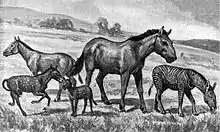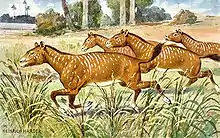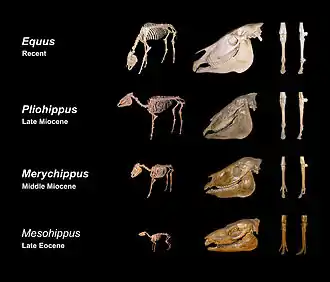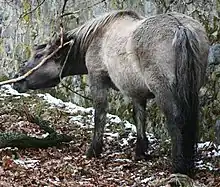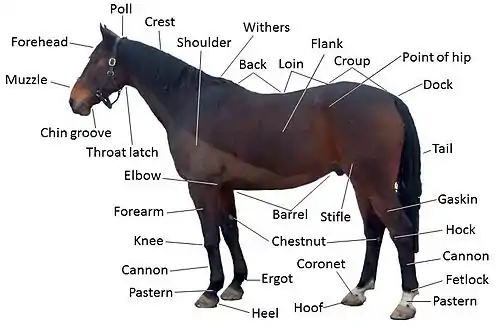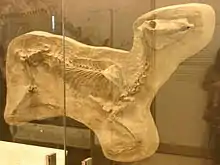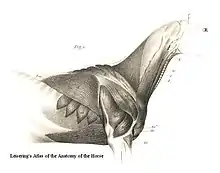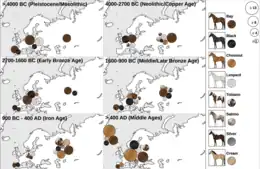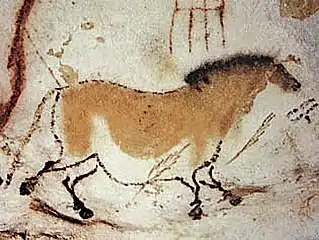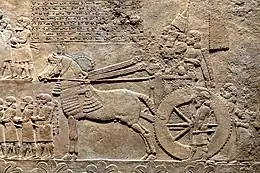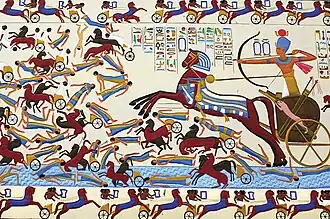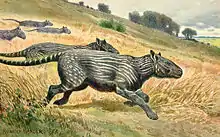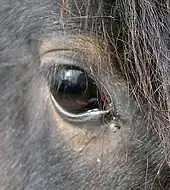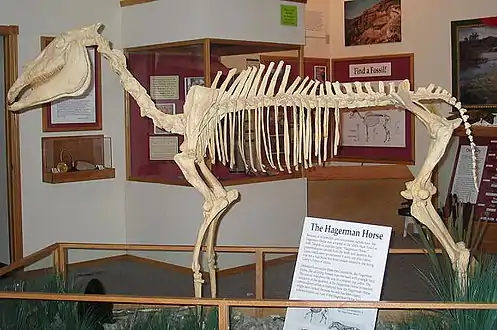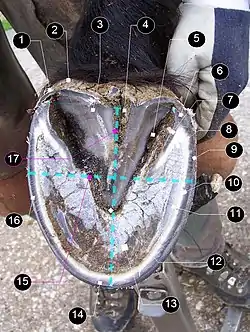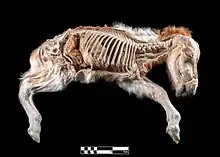The Horses Portal.jpg.webp)
The horse (Equus ferus caballus) is a domesticated, one-toed, hoofed mammal. It belongs to the taxonomic family Equidae and is one of two extant subspecies of Equus ferus. The horse has evolved over the past 45 to 55 million years from a small multi-toed creature, close to Eohippus, into the large, single-toed animal of today. Humans began domesticating horses around 4000 BCE, and their domestication is believed to have been widespread by 3000 BCE. Horses in the subspecies caballus are domesticated, although some domesticated populations live in the wild as feral horses. These feral populations are not true wild horses, which are horses that never have been domesticated. There is an extensive, specialized vocabulary used to describe equine-related concepts, covering everything from anatomy to life stages, size, colors, markings, breeds, locomotion, and behavior. Horses are adapted to run, allowing them to quickly escape predators, and possess an excellent sense of balance and a strong fight-or-flight response. Related to this need to flee from predators in the wild is an unusual trait: horses are able to sleep both standing up and lying down, with younger horses tending to sleep significantly more than adults. Female horses, called mares, carry their young for approximately 11 months and a young horse, called a foal, can stand and run shortly following birth. Most domesticated horses begin training under a saddle or in a harness between the ages of two and four. They reach full adult development by age five, and have an average lifespan of between 25 and 30 years. Horse breeds are loosely divided into three categories based on general temperament: spirited "hot bloods" with speed and endurance; "cold bloods", such as draft horses and some ponies, suitable for slow, heavy work; and "warmbloods", developed from crosses between hot bloods and cold bloods, often focusing on creating breeds for specific riding purposes, particularly in Europe. There are more than 300 breeds of horse in the world today, developed for many different uses. (Full article...)
|
| Article alerts for WikiProject Equine |
|
Categories for discussion
Requested moves
Articles to be merged
|
| Updated daily by bot |
More did you know?
- ...that Equine Hippique Canada, Canada's official national equestrian federation, describes itself as a "little known and hardly recognized" entity in Canada, despite the fact that it selects the country's Olympic teams?
- ...that the Budweiser Clydesdales were first introduced to the public on April 7, 1933, to celebrate the repeal of Prohibition?
- ... that, being a descendant of Pliohippus, Astrohippus is not considered to be an ancestor to modern horses?
- ... that the Equus Survival Trust is the only conservation organization in the world that specializes in equines?
Related portals
 Selected breed -
Selected breed - 
The Kiger mustang is a strain of mustang horse located in the southeastern part of the U.S. state of Oregon. Horses with specific conformation traits discovered in 1977, the name applies only to wild-captured individuals and does not apply to their bred-in-captivity progeny, which are known as Kiger horses. The Bureau of Land Management (BLM) administers two herd management areas for Kiger mustangs in the Burns District—Kiger and Riddle Mountain, in the Steens Mountain area. DNA testing has shown that Kiger mustangs are descended largely from Spanish horses brought to North America in the 17th century, a bloodline thought to have largely disappeared from mustang herds before the Kiger horses were found.
Kiger mustangs are most often dun in color, although they are found in other solid colors. Compact and well-muscled in appearance, their coloration and phenotype make them some of the most desired by private buyers when horses are removed from the feral herds. The BLM rounds up the horses from the two herd management areas every three to four years, and auctions excess horses to the public, returning horses to public lands that meet the desired coloration and phenotype and sometimes exchanging horses between the two herds to maintain genetic diversity. Horses in private ownership may be registered in several breed associations, the largest and oldest being the Kiger Mesteño Association, established in 1988. (Full article...)Did you know (auto-generated)
- ... that the site of Longacres has been home to a dairy farm, a horse racetrack, headquarters of a Boeing division, and a potential new facility for Seattle Sounders FC?
- ... that the plant Dyssodia papposa was given to horses for coughs by the Dakota and smoked for epilepsy by the Keres?
- ... that when built in the 1880s, London's Hesper Mews was home to servants, stables, and horses, but within a century it was populated by artists, military officers, and an Astronomer Royal?
- ... that an incident at Bridle Trails State Park resulted in a horse being euthanized?
- ... that Carrbridge Packhorse Bridge is the oldest-known stone bridge in the Scottish Highlands?
- ... that Christa Ludwig, known for fiction for young horse-lovers, received a prize after her novel about Else Lasker-Schüler's late years in Jerusalem was published?
General images
Topics
Horse • Pony • Asinus • Equus (genus) • Equidae • Zebra • Glossary of equestrian terms • List of horse breeds • Evolution of the horse • Domestication of the horse • Horse care • Stable • Horse training • Equestrianism • Horse tack • Saddle • Equine nutrition • Equine anatomy • Equine conformation • Equine coat color • Equine coat color genetics • Horse markings • Equine vision • Horse hoof • Horseshoe • Horse gait • Horse behavior • Horse breeding • Breed registry • Equine infectious anemia • Horse colic • Lameness • Laminitis • Horse slaughter • Horses in warfare • Arabian horse • Thoroughbred
Subcategories
- Select [►] to view subcategories
New articles
Rules | Match log | Results page (for watching) | Last updated: 2023-11-29 20:46 (UTC)
Note: The list display can now be customized by each user. See List display personalization for details.
- 1989 Melbourne Cup (edit | talk | history | links | watch | logs | tools) by ToddyOC (talk · contribs · new pages (3)) started on 2023-11-29, score: 30
- Akrom Yusupov (edit | talk | history | links | watch | logs | tools) by JakhongirOdilov (talk · contribs · new pages (46)) started on 2023-11-28, score: 40
- Not So Sleepy (edit | talk | history | links | watch | logs | tools) by Southdevonian (talk · contribs · new pages (1)) started on 2023-11-28, score: 40
- Altwürttemberger (edit | talk | history | links | watch | logs | tools) by Juan José Arcila M (talk · contribs · new pages (2)) started on 2023-11-28, score: 150
- 1977 Melbourne Cup (edit | talk | history | links | watch | logs | tools) by ToddyOC (talk · contribs · new pages (3)) started on 2023-11-26, score: 30
- List of mines in Australia by state (edit | talk | history | links | watch | logs | tools) by Onetwothreeip (talk · contribs · new pages (2)) started on 2023-11-26, score: 40
- List of mines in Australia by commodity (edit | talk | history | links | watch | logs | tools) by Onetwothreeip (talk · contribs · new pages (2)) started on 2023-11-26, score: 40
- Equestrian at the 2023 Pan American Games – Team eventing (edit | talk | history | links | watch | logs | tools) by JuliánLeiva66 (talk · contribs · new pages (97)) started on 2023-11-25, score: 60
- Equestrian at the 2023 Pan American Games – Individual eventing (edit | talk | history | links | watch | logs | tools) by JuliánLeiva66 (talk · contribs · new pages (97)) started on 2023-11-25, score: 80
- List of 1960s films based on actual events (edit | talk | history | links | watch | logs | tools) by WhatamIdoing (talk · contribs · new pages (6)) started on 2023-11-24, score: 50
- Falls City Stakes (edit | talk | history | links | watch | logs | tools) by Brudder Andrusha (talk · contribs · new pages (3)) started on 2023-11-24, score: 80
- Volante (carriage) (edit | talk | history | links | watch | logs | tools) by Grorp (talk · contribs · new pages (9)) started on 2023-11-24, score: 30
- 2003 European Dressage Championships (edit | talk | history | links | watch | logs | tools) by Rytter192 (talk · contribs · new pages (1)) started on 2023-11-22, score: 60
- List of Meitei traditional polo and pony cultural heritage sites (edit | talk | history | links | watch | logs | tools) by Haoreima (talk · contribs · new pages (75)) started on 2023-11-22, score: 60
- Mylord Carthago (edit | talk | history | links | watch | logs | tools) by Shellypls (talk · contribs · new pages (4)) started on 2023-11-21, score: 130
- John Littlejohn (preacher) (edit | talk | history | links | watch | logs | tools) by Generalissima (talk · contribs · new pages (20)) started on 2023-11-19, score: 30
- Domino van de Middelstede (edit | talk | history | links | watch | logs | tools) by Shellypls (talk · contribs · new pages (4)) started on 2023-11-20, score: 100
- Man of Orce (edit | talk | history | links | watch | logs | tools) by Seakingk (talk · contribs · new pages (25)) started on 2023-11-20, score: 30
- Equestrian at the 2023 Pan American Games – Team jumping (edit | talk | history | links | watch | logs | tools) by JuliánLeiva66 (talk · contribs · new pages (97)) started on 2023-11-19, score: 50
- List of programs broadcast by PBS Kids (block) (edit | talk | history | links | watch | logs | tools) by 2601:98D:C200:42E0:A938:18D5:4E9E:EB5E (talk · contribs · new pages (1)) started on 2023-11-18, score: 30
- Master of The Seas (edit | talk | history | links | watch | logs | tools) by Brudder Andrusha (talk · contribs · new pages (3)) started on 2023-11-18, score: 70
- Ace Impact (edit | talk | history | links | watch | logs | tools) by Jnglmpera (talk · contribs · new pages (1)) started on 2023-11-18, score: 50
- Equestrian at the 2023 Pan American Games – Individual jumping (edit | talk | history | links | watch | logs | tools) by JuliánLeiva66 (talk · contribs · new pages (97)) started on 2023-11-18, score: 50
- List of acts of the Parliament of England from 1536 (edit | talk | history | links | watch | logs | tools) by Mauls (talk · contribs · new pages (309)) started on 2023-11-17, score: 30
- 1908 in animation (edit | talk | history | links | watch | logs | tools) by Dimadick (talk · contribs · new pages (169)) started on 2023-11-17, score: 30
- List of acts of the Parliament of England, 1509–1535 (edit | talk | history | links | watch | logs | tools) by Mauls (talk · contribs · new pages (309)) started on 2023-11-15, score: 30
- Carriage Association of America (edit | talk | history | links | watch | logs | tools) by Grorp (talk · contribs · new pages (9)) started on 2023-11-16, score: 40
- List of acts of the Parliament of England, 1509–1536 (edit | talk | history | links | watch | logs | tools) by Mauls (talk · contribs · new pages (309)) started on 2023-11-15, score: 30
- Apulian picture vases for a funeral ceremony (Berlin Antique Collection) (edit | talk | history | links | watch | logs | tools) by Jhanvi25 (talk · contribs · new pages (8)) started on 2023-11-15, score: 30
WikiProjects
- Equine Wikiproject
- Horse Breed Taskforce
- Horse Training Taskforce
- Horse racing Wikiproject
- Veterinary medicine Wikiproject
- Agriculture Wikiproject
Associated Wikimedia
The following Wikimedia Foundation sister projects provide more on this subject:
-
 Commons
Commons
Free media repository -
 Wikibooks
Wikibooks
Free textbooks and manuals -
 Wikidata
Wikidata
Free knowledge base -
 Wikinews
Wikinews
Free-content news -
 Wikiquote
Wikiquote
Collection of quotations -
 Wikisource
Wikisource
Free-content library -
 Wikispecies
Wikispecies
Directory of species -
 Wikiversity
Wikiversity
Free learning tools -
 Wiktionary
Wiktionary
Dictionary and thesaurus
-
 List of all portalsList of all portals
List of all portalsList of all portals -
 The arts portal
The arts portal -
 Biography portal
Biography portal -
 Current events portal
Current events portal -
 Geography portal
Geography portal -
 History portal
History portal -
 Mathematics portal
Mathematics portal -
 Science portal
Science portal -
 Society portal
Society portal -
 Technology portal
Technology portal -
 Random portalRandom portal
Random portalRandom portal -
 WikiProject PortalsWikiProject Portals
WikiProject PortalsWikiProject Portals
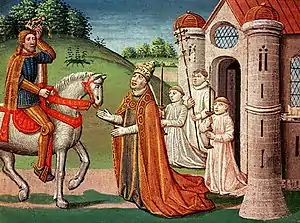
.jpg.webp)

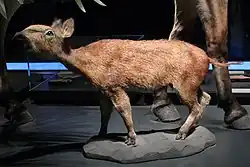
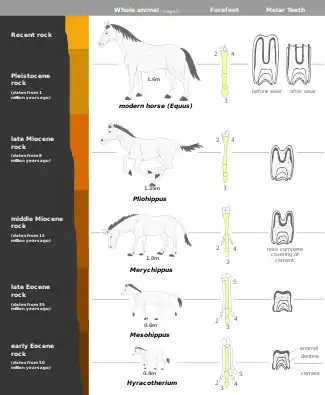
%252C_stored_at_the_Lyndon_B._Johnson_Presidential_Library.jpg.webp)

